Green Wednesday: Rare Piebald Deer and Tomato Growing Tips
By Kathleen Scavone, Environmental Contributor and Mike Lecours, UC Master Gardener of Napa County
We Need Your Help
If you’re reading this, you care about independent, locally owned, ad-free journalism — reporting that puts our region’s stories first, not corporate interests or clickbait.
Join a community that values in-depth, independent reporting. Become a paid subscriber today — and if you already are, thank you. Help us grow by liking, commenting and sharing our work.
Green Wednesday: Gardening and Ecological Insights
Every Wednesday Napa Valley Features brings you Green Wednesday, featuring articles from environmental voices and the UC Master Gardeners of Napa County. These contributors share research-based horticultural advice and insights on sustainability and climate topics relevant to our region.
Summary of Today’s Stories
"A Rare Sighting of Piebald Deer" by Kathleen Scavone, Environmental Contributor recounts her chance encounter with a herd of rare piebald black-tail deer and explores their ecological significance, genetic traits and the vital role deer play in healthy ecosystems.
"The rays of soft spring light alter the landscape, bringing to witness any number of surprises — even a herd of piebald deer!" — Kathleen Scavone, Environmental Contributor
"Use These Tips to Help Tomatoes Thrive" by Mike Lecours, UC Master Gardener of Napa County includes expert advice on selecting, planting and caring for tomatoes in Napa Valley, with practical tips tailored to local climate conditions for a bountiful harvest.
"If you follow these steps, you might harvest more tomatoes than you know what to do with." — Mike Lecours, UC Master Gardener of Napa County
A Rare Sighting of Piebald Deer
By Kathleen Scavone
NAPA VALLEY, Calif. — The two-tone deer known as piebald are not as scarce as leucistic or albinos, but piebald black-tail deer are rarely seen. Piebald or pied animals that have unpigmented areas on a pigmented background can include cats, foxes, birds and more.
Recently I watched as a pair of nuthatches painstakingly constructed a nest with grass and moss. Then I spied a pair of hawks soaring above. As I became mesmerized with the aerial ballet, a herd of six skittish piebald deer made their way past the oaks to a small opening next to a creek near the Lake and Napa border. I did a double-take as I noted the buff-toned deer with white hind quarters. I grabbed my camera and snapped a few shots before they disappeared back into the woods. When I took a closer look at photos of the herd, I noted that some of the deer, all adults, were spotted with traces of the unusual coloration.
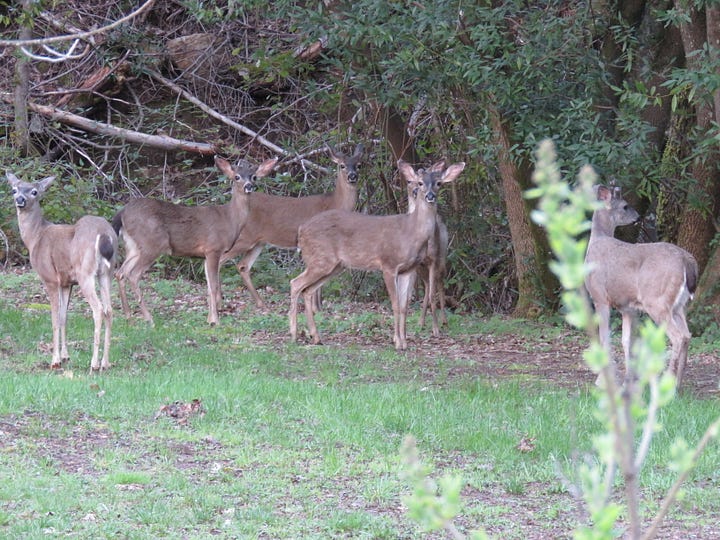
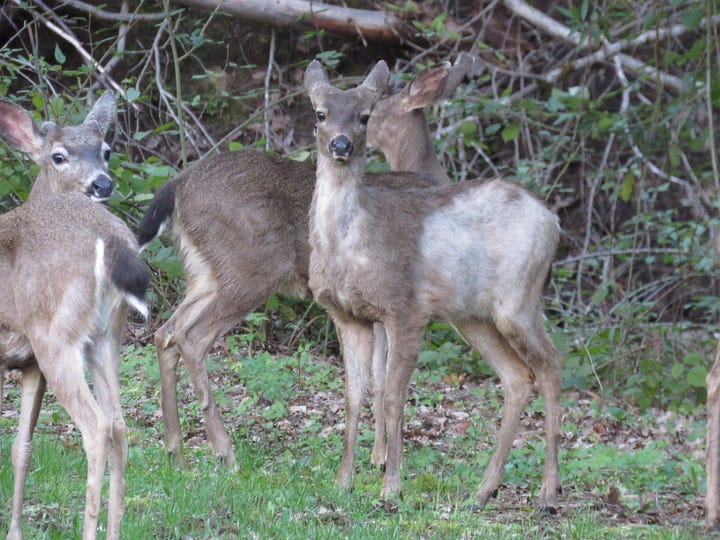
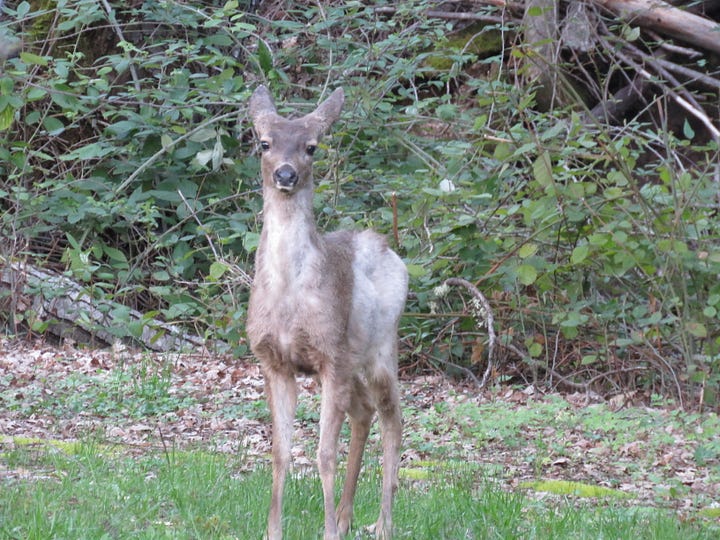
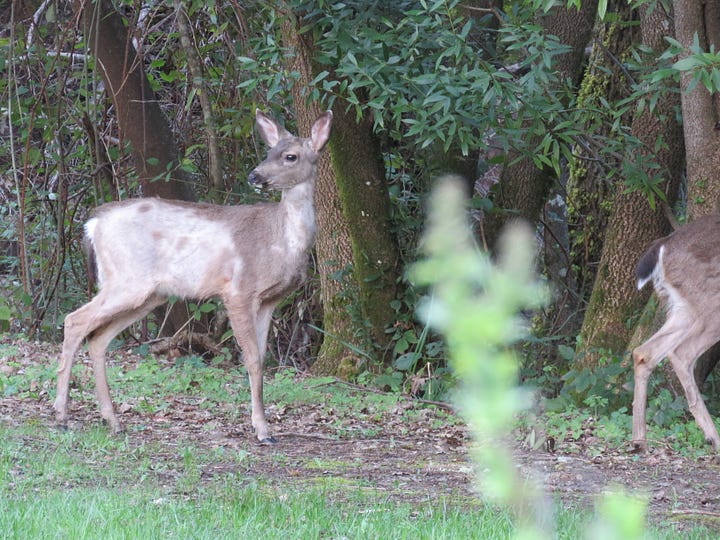
I contacted Krysten Kellum, information officer at the California Department of Fish and Wildlife office in Sacramento to inquire about the herd and their traits. I also asked if piebald deer have been previously sighted in Napa County.
"CDFW does receive reports of piebald deer, but it’s rare,” Kellum said. “The recessive genetic mutation that affects melanocytes or pigmentation can occur anywhere in the state. Both parents must carry the recessive trait for the offspring to be piebald. Where it occurs indicates the recessive genetic trait is in that herd/population. Piebald populations are not tracked or monitored as their coloring is not a concern for conservation or management but we have had reports out of Sacramento, Napa and Sonoma counties."
Kellum added, "There are two subspecies of deer in California: black-tailed deer (Odocoileus hemionus columbianus) and mule deer (Odocoileus hemionus)."
She identified the herd I saw as black-tail deer. The black-tailed subspecies inhabits the Pacific Coast region from Alaska to Santa Barbara County, California.
The black-tail animals are smaller than the subspecies mule dee. Their diet includes flora for browsing, such as maple, grasses, blackberries, salal, Douglas fir, lichens and more. Deer are an important component of a healthy ecosystem. Just as a keystone in an architectural arch locks the rest of the stones into place, deer are known as a keystone species.
Deer are crucial to the ecosystem since they have a large impact on many species of flora, fauna and the soil's health. Wildlife biologists have learned that the rise and fall of deer population numbers can have an effect on factors such as the availability of both their food and the availability of food for other wildlife. When there are too many deer, overgrazing of forests and lands can occur, leading to less plant diversity. Other wildlife species might also be affected negatively if they rely on similar plants for food and shelter. Conversely, when deer populations decrease, the composition of the forest can alter and may lead to some habitat changes as some plant species become predominant.
Rutting or mating season takes place in November and December. The doe's gestation takes six to seven months, which means their fawns are born during the months of late May to June. Most often nature provides them with twins that weigh between 6 and 8 pounds. Diminutive fawns' spotted fur aids in camouflage, hiding them from predators such as mountain lions, bobcats and sometimes coyotes. Fawns, born scentless, nurse shortly after they are born and begin to stand at approximately 12 hours. They will remain with their mothers until winter's end.
NapaWildlifeRescue.org explains that fawns and deer face many threats each year. Fawn mortality is 38% to 77% annually in some areas. They stress that it is important to leave wild animals alone and not to feed or chase them. If deer are fed human food, there is a risk of serious health problems or disease transmission if one animal is ill. If there is a need, Napa Wildlife Rescue can be contacted for instructions. Vehicles are a huge threat to deer. When drivers notice a deer, they should slow down since there might be more than one.
The rays of soft spring light alter the landscape, bringing to witness any number of surprises — even a herd of piebald deer! Nature's rhythms of water, earth and sun are an unending source of energy with loads of lessons waiting to be learned.
—
Kathleen Scavone, M.A., retired educator, is a potter, freelance writer and author of “Anderson Marsh State Historic Park: A Walking History, Prehistory, Flora and Fauna Tour of a California State Park,” "People of the Water" and “Native Americans of Lake County.” She loves hiking, travel, photography and creating her single panel cartoon called “Rupert.”
Use These Tips to Help Tomatoes Thrive
By Mike Lecours, UC Master Gardener of Napa County
NAPA VALLEY, Calif. — It’s tomato planting time, and if you’re like me, you’re excited to get your tomato babies in the ground and growing. I’m going to share some tricks and tips for growing big, healthy tomatoes here in Napa Valley. So let’s get started.
If you haven’t purchased your plants already, the first step is to select varieties that grow well in our climate. Ask your neighbors which varieties they have grown successfully. You can also ask at your local garden store or select from the list provided by the University of California.
UC researchers have divided our state into three tomato-growing zones. Napa Valley is in zone A, which has the most choices. You can find the list and more tomato-growing tips in the UC Agriculture and Natural Resources publication “Growing Tomatoes in the Home Garden.” Many of the varieties listed are available at local garden centers.
Now that you’ve chosen your seedlings, you’ll need to select a good location. Tomatoes like lots of sun, so pick a location that gets six or more hours of direct sunlight each day. If you have a shady yard, this requirement might be an issue. Fortunately, tomatoes grow well in containers. If you have a sunny patio or deck, you’re in luck.
Tomatoes also need space. Notice that tomato varieties are identified as either determinate or indeterminate. This distinction indicates how large the full-grown plant will be. Determinate varieties typically grow 3 to 5 feet tall and then stop growing. Indeterminate varieties grow all season long and will get as big as you let them. These vigorous growers need tomato cages or stakes for support.
If you’re planning to grow your tomatoes in containers, determinate varieties will work best. You can find out more about growing in containers on the Napa County Masters Gardeners website.
Plant seedlings once the soil temperature reaches 60 F, usually by May 1 around here. Before you plant, water your seedlings thoroughly. Remove any lower leaves, leaving only the stem and the top few leaves. Carefully remove your seedling from its container and plant it deeply, covering the stem with soil up to the top leaves. The buried stem will sprout roots, making for a sturdier, healthier plant. Finally, place mulch around the seedling, keeping it clear of the stem. The mulch will minimize weeds and help the soil retain water. Both straw and compost make a good mulch for tomatoes.
Your tomatoes are going to need water, but how often depends on the weather. You may only need to water once a week in the spring but two to three times a week in the heat of summer. When you water, moisten the soil to a depth of 2 to 3 inches.
Inconsistent watering is a major cause of cracked fruit and blossom-end rot. You can water by hand if you’re diligent, but I’m not, so I installed irrigation with a hose timer. Whatever method you choose, apply water at the base of the plant. Avoid wetting the leaves, which can lead to fungal diseases.
Tomatoes are heavy feeders, but you don’t need to fertilize until plants set their first fruit. Choose a fertilizer formulated for tomatoes and follow package directions.
You should see your first tomatoes in about six weeks. Keep the fruit off the ground to prevent rot.
If you follow these steps, you might harvest more tomatoes than you know what to do with. Share with friends and neighbors or check out the Napa County Library’s collection of tomato-themed cookbooks. They have quite a few.
For more guidance on growing tomatoes, check the Resource section of the Napa County Master Gardeners website.
Events
Tree Walk: UC Master Gardeners of Napa County will lead a tree walk through Napa’s Fuller Park on Friday, May 16, from 10 to 11:30 a.m. Fuller Park contains many exotic and native trees that have been planted over the last 120 years. Tour begins at the corner of Oak and Jefferson streets in Napa. The walk is free, but space is limited and registration is required.
Workshop: Join UC Master Gardeners of Napa County for a workshop on “Bringing Natives Home: Designing a Garden With California Native Plants,” on Saturday, May 31, from 10 a.m. to noon at the UC Cooperative Extension, 1710 Soscol Ave., Napa. The Las Flores Native Plant Garden Team will show you how to include and care for native plants in your garden. Register here.
Help Desk: The Master Gardener Help Desk is available to answer your garden questions on Mondays and Fridays from 10 a.m. until 1 p.m. at the University of California Cooperative Extension Office, 1710 Soscol Ave., Suite 4, Napa. Or send your questions to mastergardeners@countyofnapa.org. Include your name, address, phone number and a brief description of the problem. For best results attach a photo.
—
Mike Lecours is a UC Master Gardener of Napa County.








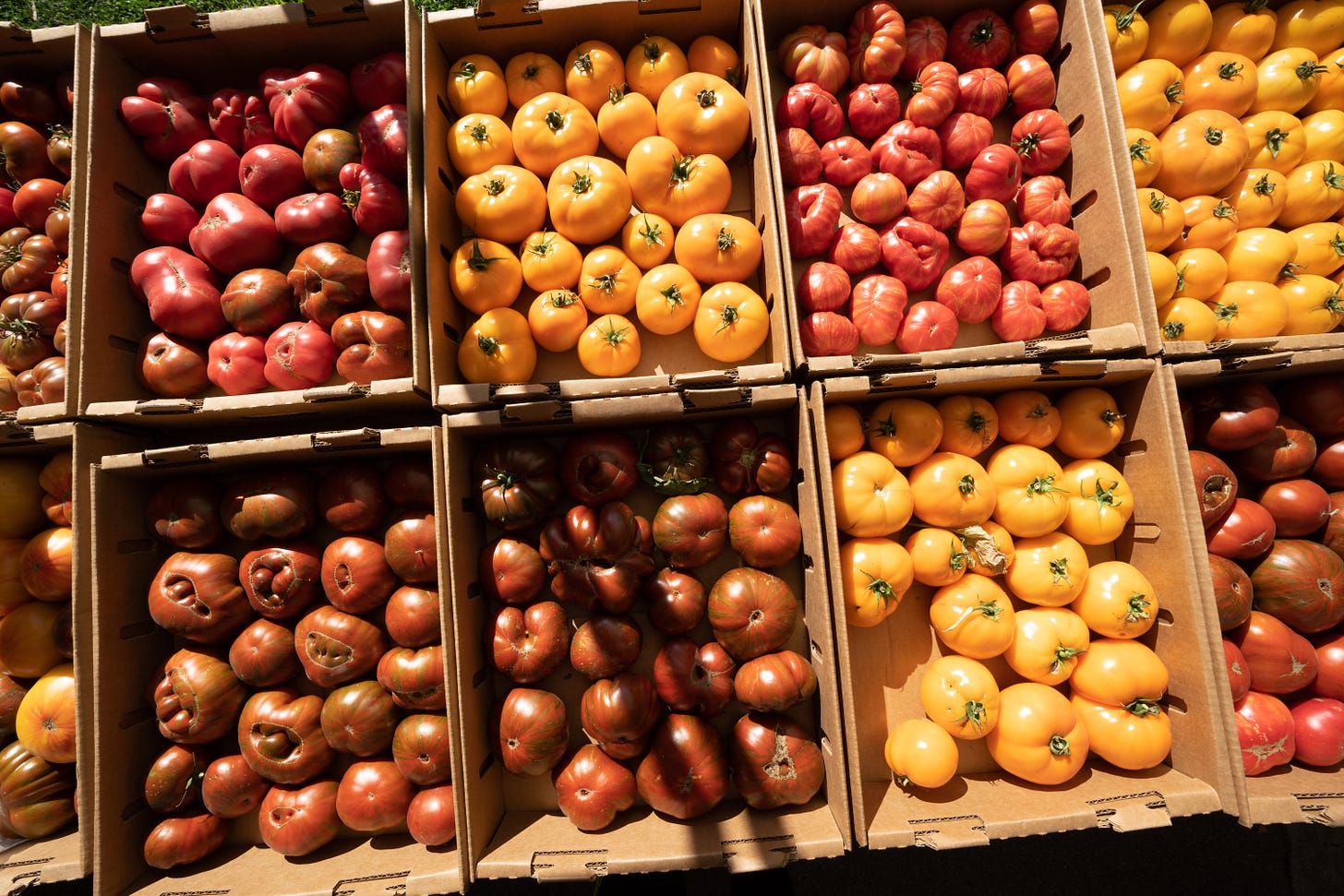




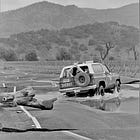
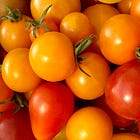
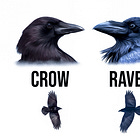

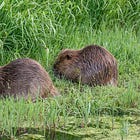






Great advice Mike!